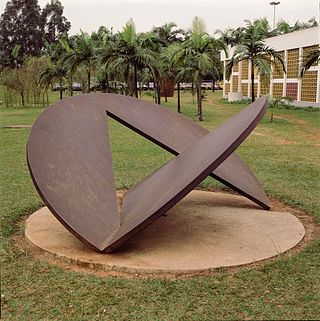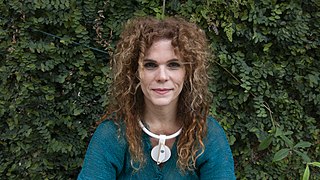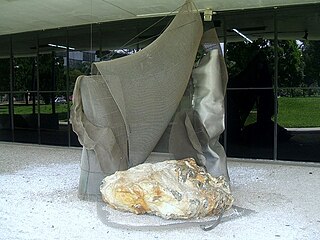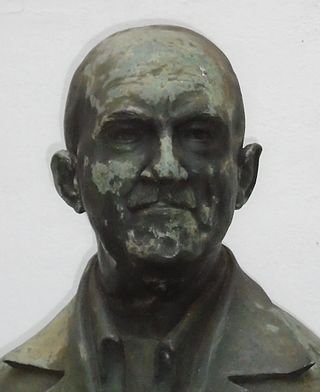Related Research Articles

The Guignard University of Art of Minas Gerais is a university of fine arts in Belo Horizonte, Minas Gerais, Brazil. It was founded on 28 February 1944 by the Brazilian painter Alberto da Veiga Guignard (1896-1962) on request of Juscelino Kubitschek, mayor of Belo Horizonte and later President of Brazil. Guignard became a noted arts educator in Brazil and remained a professor at Guignard for the remainder of his life.
Yara Tupynambá Gordilho Santos is a Brazilian visual artist.

Amílcar Augusto Pereira de Castro was a Brazilian artist, sculptor and graphic designer.

Laura Lima is a contemporary Brazilian artist who lives and works in Rio de Janeiro. Since the 1990s, Lima has discussed in her works the matter of alive beings, among other topics. Her works can be found in the collections of institutions such as Bonniers Konsthall, Stockholm, Sweden; Inhotim Institute, Brumadinho, Brazil; MAM - Museum of Modern Art, São Paulo, Brazil; Migros Museum für Gegenwartskunst, Zurich, Switzerland; Pinacoteca of the State of São Paulo, Brazil; Itaú Cultural, São Paulo, Brazil; Pampulha Museum of Art, Belo Horizonte, Brazil; National Museum of Fine Arts, Rio de Janeiro, Brazil; Hammer Museum, Los Angeles, USA; MASP - Museum of Art of São Paulo, Brazil, among others.

Iole Antunes de Freitas is a Brazilian sculptor, engraver, and installation artist who works in the field of contemporary art. Freitas began her career in the 1970s, participating in a group of artists in Milan, Italy linked to Body art. She used photography. In the 1980s, she returned to Brazil, but abandoned the human body as mediator of her work, adopting the "sculpture body". The artist uses materials such as wire, canvas, steel, copper, stone, and water to create her works.

Franz Josef Weissmann was a Brazilian sculptor born in Austria, emigrating to Brazil while he was eleven years old. Geometric shapes, like cubes and squares, are strongly featured in his works. He was one of the founders of the Neo-Concrete Movement.

Alberto da Veiga Guignard also known as Alberto Guignard or Guignard was a Brazilian painter who became renowned for his depictions of the landscapes of Minas Gerais.

Regina Silva Silveira is a Brazilian artist known for her work with light, shadows and distortions exploring ideas of reality. Silveira has used many media throughout her career but focuses mainly on videography, painting, and printmaking She is based in São Paulo.

Edith Behring was a Brazilian artist and educator.
Vera Chaves Barcellos is a Brazilian artist and educator. She was featured in the Radical Women show at the Brooklyn Museum in 2018.
Valeska Soares is a Brooklyn-based Brazilian-American sculptor and installation artist.

Wanda Pimentel was a Brazilian painter, based in Rio de Janeiro, Brazil. Her work is distinguished by "a precise, hard-edge quality encompassing geometric lines and smooth surfaces in pieces that often defy categorization as abstract or figurative. “My studio is in my bedroom,” Pimentel said in an interview. “Everything has to be very neat. .. I work alone. I think my issues are the issues of our time: the lack of perspective for people, their alienation. The saddest thing is for people to be dominated by things.”
Mara Alvares is a Brazilian artist. She mainly specialized in photography as one of her notable works is the Adansônia. She first studied metal engraving with the Universidade Federal do Rio Grande do Sul with Iberê Camargo.
Celeida Tostes (May 26, 1929 in Rio de Janeiro – January 3, 1995 in Rio de Janeiro was a Brazilian female drawing teacher and artist, specifically a sculptor and ceramist, that focused on Postwar and Contemporary Art.
Teresinha Soares is a Brazilian pop art artist who currently lives and works in Belo Horizonte, Brazil. She produced art during the 1960s and 1970s and was best known for her erotic artwork that explored femininity and pushed back against Brazil's oppressive government.
Martha Araújo in Maceió, Brazil is a Brazilian sculptor and performance artist. She lives and works in Maceió the capital of Alagoas in Brazil. The style of her work was performance and sculpture art. She also explored her body with her performances. Her art emerged at the end of a military dictatorship that lasted from 1964 to 1985. She used their experiences during the dictatorship in her artwork to show how they felt trapped. Using textiles Araújo demonstrates the limit of the body through the play between repression and freedom. However, sculptures and performances were not her only interest she has also explored photography and video.
Maria Virginia Errázuriz Guilisasti, also known as Virginia Errázuriz, is a Chilean painter, professor, printmaker and draftsperson.
Neide Dias de Sá is a Brazilian artist who spent a big portion of her life teaching children art starting in the 1960s. Together with three others, she began an art movement in 1967 known as Poema/Processo. This art movement questioned the restraints that came with using words and replaced words with pictures. She did this years before pursuing a formal education in art. She did not earn her degree in graphic design until 1980.
Grupo Ruptura was created by a collection of artists who sought to advance modern art in Brazil in the 1950s. Together, they held an exhibition entitled Ruptura at the São Paulo Museum of Modern Art in 1952. The group embraced concrete art as a break from traditional naturalistic painting popular in Brazil at the time. Grupo Ruptura's works are often characterized by strong geometric shapes and bold colors.

Maria Alice da Silva Jorge was a Portuguese painter, engraver, ceramicist, and book illustrator and co-author of a book on engraving for students. Initially following a neorealist style, her work later became more abstract. One of the most important personalities in the Portuguese engraving renewal movement of the 1950s, she was banned from teaching art for 19 years because of her support for the families of political prisoners.
References
- 1 2 "Liliane Dardot | Radical Women digital archive". Hammer Museum. Retrieved 2019-05-01.
- 1 2 Cultural, Instituto Itaú. "Liliane Dardot". Enciclopédia Itaú Cultural (in Brazilian Portuguese). Retrieved 2019-05-01.
- ↑ "Radical Women: Latin American Art, 1960–1985". Art and Cake. 2017-11-19. Retrieved 2019-05-30.